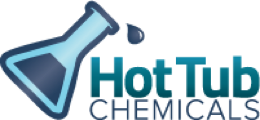Hot Tub Chemicals 101
Important Info From Canada's Hot Tub Chemicals & Accessories Leader
Your hot tub is a great source of relaxation, comfort and enjoyment. The jets of the hot tub offers a mild massage, relieving stress and tension from your muscles after a long day. The warm, swirling water helps to relax your body and can improve overall circulation in your body. Everyone uses their hot tub for different reasons, and some use it more frequently than others. To get the most satisfaction out of your hot tub, the water must look clear, enticing and be free of bacteria. Three important factors contributing to this are filtration, water balance and disinfection. This page is a guide to hot tub water care. You will learn about caring for your hot tub , and how water conditions can be controlled.Bookmark this page as a guide in case of trouble or if water imbalance should arise.
Disinfection
Disinfecting your hot tub water means killing the harmful bacteria and keeping the water clean. HotTubChemicals.ca offers several types of disinfectant systems to choose from: chlorine and bromine being the most common. Both have their advantages.
Chlorine:
There are different types of chlorine treatments available to you. We believe stabilized chlorine in tablet or granular form is best suited for outdoor hot tubs. Spa Tabs are 90% available chlorine and offer a continual slow release of disinfectant. Tabs require a feeder or skimmer basket to dissolve. Chlor-Aid granular chlorine dissolves completely and immediately for instant disinfection, and it doesn't alter the pH levels.
Bromine:
There are two common types of bromine systems. One is a granular, and the other is a tablet. The only difference is how you add it to the hot tub water. The granules can be added directly to the hot tub water, and the tablets should be put into the skimmer basket or better yet, in a a floating dispenser. The bromine level should be between 3 and 5 p.p.m.
Shock Treatment:
After using your hot tub, body oils, perspiration, hair and dirt accumulate which can turn your spa water cloudy. Periodic shock treatments with Spa Shock will oxidize these organic contaminants. Spa Shock is compatible with both chlorine and bromine disinfectant systems.
| Trichloro Tablets (SpaBoss Spa Tabs) | Dichloro Granular (SpaBoss Chlor Aid) | Granular Bromine (SpaBoss Bromine Granules | Bromine Tablets (SpaBoss Bromine Tabs) |
|
|
|
|
Water Balance
Water balance is important to the overall performance of your hot tub. No two hot tub water conditions are exactly alike. The water source, location of the spa and the frequency of use, all effect the water balance. Unbalanced water can damage the equipment, make the water uncomfortable for the user, and decrease the effectiveness of the disinfectant. Total alkalinity, pH, and calcium hardness must be within the correct ranges to balance the water.
pH:
Simply, pH is a scale indicating whether spa water is basic, neutral or acidic. Spa water should be slightly basic with a reading of 7.2 - 7.6 A low pH (below 7.2) leads to corrosion of spa equipment and will irritate the skin of the bathers. Also, the sanitizer will dissipate more rapidly. A low pH can be corrected by adding pH Booster. A high pH (above 7.6) promotes scaling on heat exchange tubes, creates cloudy water, calcium deposits and reduces the effectiveness of disinfecting agents. A high pH can be corrected by adding pH Reducer.
Alkalinity:
Total alkalinity is a measure of the alkaline in the water. They act as a pH buffer or a pH stabilizer preventing large changes in the pH. The total alkalinity should be between 80-150 p.p.m.; ideally 120 p.p.m. Tablet chlorines and bromine tend to gradually lower the alkalinity level. A low total alkalinity causes:
- the pH to wander
- corrosive water
- disinfectants to be ineffective To raise the total alkalinity add Alka Rise.
A high total alkalinity causes:
- cloudy water
- scale formation
To lower the total alkalinity add pH Reducer.
Calcium Hardness:
Calcium hardness is the hardness present due to dissolved calcium. The desired range is 150 - 280 p.p.m. A low calcium hardness causes:
- corrosive water
- staining of surfaces
To raise calcium hardness add Cal Rise. A high calcium hardness causes:
- scaling of heating pipes
- cloudy water
- staining of spa
To correct this problem add Prevent II. Do not fill the hot tub with soft water!
